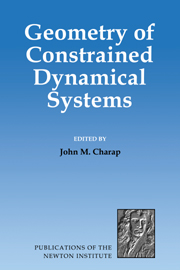Book contents
- Frontmatter
- Contents
- The network
- Preface
- The constraint algebra of higher dimensional Chern-Simons theories
- Nonrelativistic Chern-Simons vortices from the constrained Hamiltonian formalism
- Classical solutions of gravitating Chern-Simons electrodynamics
- Exponentially localised instantons in a hierarchy of Higgs models
- Obstructions to ganging WZ terms: a symplectic curiosity
- Global aspects of symmetries in sigma models with torsion
- Canonical structure of the non-linear σ-model in a polynomial formulation
- A manifestly gauge-invariant approach to quantum theories of gauge fields
- On the Hamiltonian formulation of higher dimensional Chern-Simons gravity
- An Example of Loop Quantization
- Gauge fixing in constrained systems
- Light-cone formulation of gauge theories
- Hamiltonian constraints and Dirac observables
- Gauging kinematical and internal symmetry groups for extended systems
- On the harmonic interaction of three relativistic point particles
- Non existence of static multi-black-hole solutions in 2+1 dimensions
- Spherically symmetric gravity and the notion of time in general relativity
- Canonical decomposition of Belinskii-Zakharov one-soliton solutions
- Hamiltonian reduction and the R-matrix of the Calogero model
- Intrinsic approach to the Legendre transformation in super-mechanics
- Field-antifield description of anomalous theories
- Transfer matrix quantization of general relativity, and the problem of time
- The W3-particle
- Pure geometrical approach to singular Lagrangians with higher derivatives
- Dirac versus reduced phase space quantization
- Classical and quantum aspects of degenerate metric fields
- BRST-antibracket cohomology in 2d conformal gravity
- Quantisation of 2 + 1 gravity for g = 1 and g = 2
- Geometry and dynamics with time-dependent constraints
- Collective coordinates and BRST transformations or Gauge theories without gauge fields
- Geometry of fermionic constraints in superstring theories
- BRST and new superstring states
- Generalized canonical quantization of gauge theories with polarized second–class constraints
- Radiation field on superspace
- Participants
Spherically symmetric gravity and the notion of time in general relativity
Published online by Cambridge University Press: 05 November 2011
- Frontmatter
- Contents
- The network
- Preface
- The constraint algebra of higher dimensional Chern-Simons theories
- Nonrelativistic Chern-Simons vortices from the constrained Hamiltonian formalism
- Classical solutions of gravitating Chern-Simons electrodynamics
- Exponentially localised instantons in a hierarchy of Higgs models
- Obstructions to ganging WZ terms: a symplectic curiosity
- Global aspects of symmetries in sigma models with torsion
- Canonical structure of the non-linear σ-model in a polynomial formulation
- A manifestly gauge-invariant approach to quantum theories of gauge fields
- On the Hamiltonian formulation of higher dimensional Chern-Simons gravity
- An Example of Loop Quantization
- Gauge fixing in constrained systems
- Light-cone formulation of gauge theories
- Hamiltonian constraints and Dirac observables
- Gauging kinematical and internal symmetry groups for extended systems
- On the harmonic interaction of three relativistic point particles
- Non existence of static multi-black-hole solutions in 2+1 dimensions
- Spherically symmetric gravity and the notion of time in general relativity
- Canonical decomposition of Belinskii-Zakharov one-soliton solutions
- Hamiltonian reduction and the R-matrix of the Calogero model
- Intrinsic approach to the Legendre transformation in super-mechanics
- Field-antifield description of anomalous theories
- Transfer matrix quantization of general relativity, and the problem of time
- The W3-particle
- Pure geometrical approach to singular Lagrangians with higher derivatives
- Dirac versus reduced phase space quantization
- Classical and quantum aspects of degenerate metric fields
- BRST-antibracket cohomology in 2d conformal gravity
- Quantisation of 2 + 1 gravity for g = 1 and g = 2
- Geometry and dynamics with time-dependent constraints
- Collective coordinates and BRST transformations or Gauge theories without gauge fields
- Geometry of fermionic constraints in superstring theories
- BRST and new superstring states
- Generalized canonical quantization of gauge theories with polarized second–class constraints
- Radiation field on superspace
- Participants
Summary
Abstract
It is shown - in Ashtekar's canonical framework of General Relativity - that the constraints of spherically symmetric (Schwarzschild) gravity in 4 dimensional space-time can be solved completely yielding two canonically conjugate observables for asymptotically flat spacetimes, namely mass and - surprisingly - time. The emergence of the time observable is a consequence of the Hamiltonian formulation and its subtleties concerning the slicing of space and time and is not in contradiction to Birkhoff's theorem. Our results can be expressed within the ADM formalism, too, and their relation to the equivalent ones Kuchař obtained recently are briefly discussed. Quantization of the system and the associated Schrödinger equation depend on the allowed spectrum of the masses.
Introduction
The issue ‘time’ is perhaps the most crucial one in canonical - especially quantum - gravity and a number of different approaches have been pursued in recent years (see the excellent reviews[1, 2]). Whereas the discussions of general aspects are certainly essential, one might possibly learn a lot by the analysis of a single - even very simple - system for which the corresponding quantisation can be carried through completely and in which the quantity time appears as a classical and quantum gauge invariant ‘observable’.
Such a system is spherically symmetric pure gravity. In view of Birkhoff's theorem which seems to eliminate completely the notion of time for such systems this assertion may appear to be quite surprising.
Information
- Type
- Chapter
- Information
- Geometry of Constrained Dynamical Systems , pp. 158 - 172Publisher: Cambridge University PressPrint publication year: 1995
